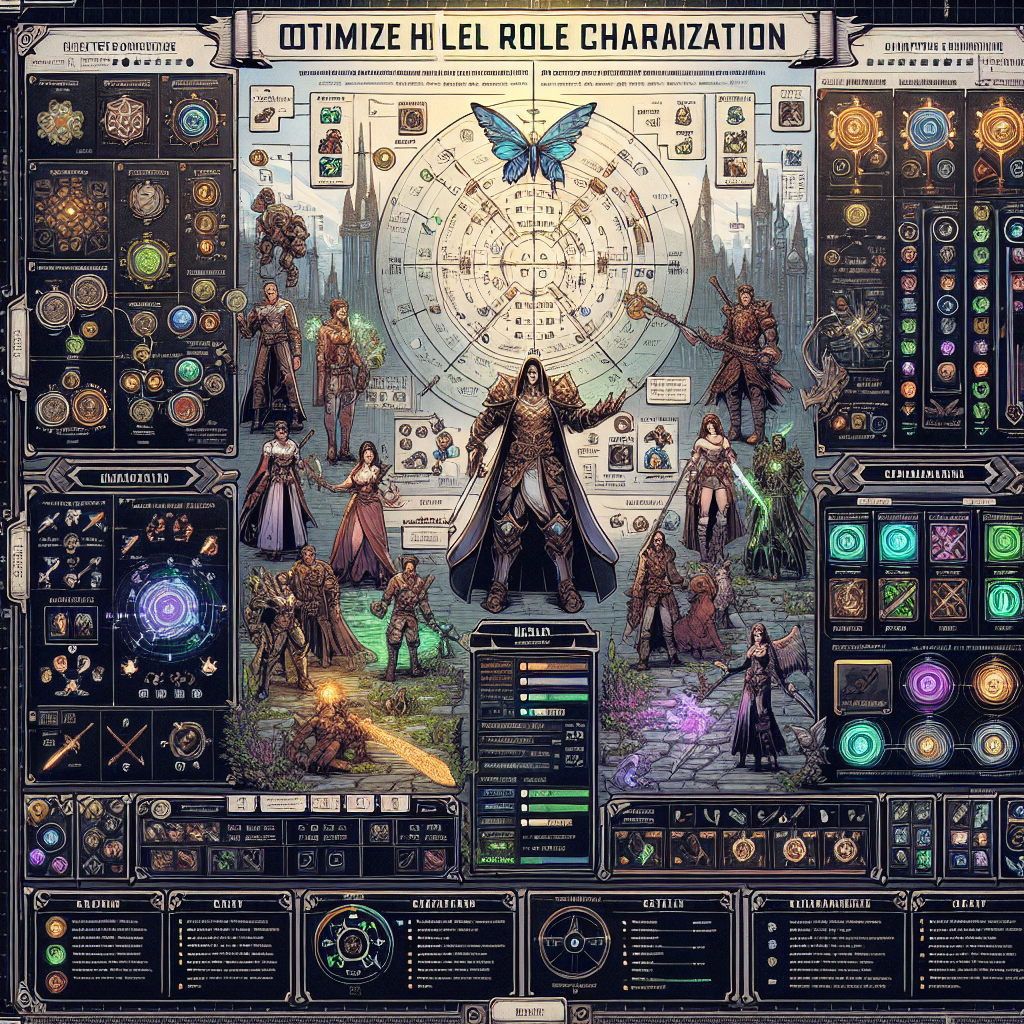Ultimate Guide to Min-Maxing Healer Builds in World of Warcraft
Master the art of healing efficiency, learn specific talent choices, gear optimizations, and rotation strategies to maximize your healing output in high-level PvE content.
As a healer in World of Warcraft, your primary responsibility is to keep your party or raid group alive and thriving, even in the most challenging encounters. While healing can be a rewarding and impactful role, it also requires a deep understanding of your class mechanics, talent choices, gear optimization, and rotation strategies to truly excel. In this comprehensive guide, we'll dive deep into the principles of min-maxing healer builds to help you become a healing powerhouse in high-level PvE content.
Talent Choices for Optimal Healing
The talent tree for your chosen healing specialization is the foundation of your build, and making the right choices can significantly impact your overall healing output and efficiency. Let's explore the key talent considerations for each of the three main healing classes in World of Warcraft:
Restoration Druid
As a Restoration Druid, your talent choices should focus on enhancing your ability to provide sustained, multi-target healing while maintaining mobility. Some of the must-have talents in the Restoration Druid tree include:
- Cultivation: Increases the healing done by your Rejuvenation spell, a crucial HoT (Heal over Time) ability.
- Flourish: Empowers your Rejuvenation and Wild Growth spells, allowing you to quickly top up multiple targets.
- Germination: Enables you to apply two Rejuvenation effects on a single target, further boosting your sustained healing.
- Cenarion Ward: Provides a powerful, reactive heal that can be used to support vulnerable group members.
Holy Paladin
Holy Paladins excel at targeted, bursty healing, as well as providing valuable utility and defensive cooldowns. Key talents to consider for this specialization include:
- Crusader's Might: Reduces the cooldown of your powerful Holy Shock ability, allowing you to use it more frequently.
- Bestow Faith: Grants a powerful, delayed heal that can be used to preemptively support your allies.
- Aura Mastery: Significantly enhances the effectiveness of your party-wide Aura abilities, providing valuable group-wide buffs.
- Light's Hammer: A versatile, ground-targeted healing ability that can be used to blanket an area with healing.
Discipline Priest
Discipline Priests are unique in their ability to provide proactive, shielding-based healing. Their talent choices should focus on maximizing the efficiency and potency of their shielding abilities. Consider the following key talents:
- Schism: Increases the damage and healing done by your Penance ability, a crucial part of your healing rotation.
- Power Infusion: Grants a powerful haste buff, allowing you to cast spells more rapidly and generate more healing.
- Evangelism: Empowers your Atonement effect, which allows your damage-dealing spells to heal your allies.
- Purge the Wicked: Applies a damage-over-time effect that can be used to proactively heal your party members.
Regardless of your chosen healing specialization, it's essential to carefully analyze the talent options and select the ones that best complement your playstyle and the demands of the content you're tackling.
Gear Optimization for Healing Efficiency
Gearing your healer character is a crucial aspect of min-maxing your build. The right combination of stats, item levels, and set bonuses can significantly enhance your healing output and overall efficiency. Let's explore the key gear considerations for each healing specialization:
Restoration Druid
As a Restoration Druid, your primary stats of focus should be:
- Intellect: This stat directly increases your spell power and healing output.
- Haste: Haste allows you to cast spells more quickly, improving your overall healing throughput.
- Mastery: The Restoration Druid's Mastery, "Harmony," increases the healing done by your HoT abilities.
When it comes to set bonuses, the Mythic+ and Raid sets are particularly impactful for Restoration Druids, as they often provide synergistic effects that enhance your core abilities.
Holy Paladin
For Holy Paladins, the essential stats to prioritize are:
- Intellect: As with other healing classes, Intellect is the primary stat that boosts your healing power.
- Haste: Haste allows you to cast spells more frequently, improving your reactive healing capabilities.
- Versatility: Versatility increases both your healing and damage output, making it a valuable stat for Holy Paladins.
Set bonuses for Holy Paladins can provide valuable defensive utilities, such as improved damage reduction or increased healing on low-health targets.
Discipline Priest
Discipline Priests have a unique gearing approach, as they rely heavily on their shielding abilities. The primary stats to focus on are:
- Intellect: Increases your overall healing and shielding power.
- Critical Strike: Critical Strike chance can enhance the potency of your Atonement healing and shield effects.
- Haste: Haste allows you to cast spells more frequently, improving your shielding uptime and overall healing efficiency.
Set bonuses for Discipline Priests often focus on improving the effectiveness of their shielding abilities or enhancing the synergy between their damage-dealing and healing spells.
Regardless of your healing specialization, it's essential to carefully review and optimize your gear to ensure that you're maximizing your healing output and efficiency.
Rotation Strategies for Optimal Healing
Mastering your healing rotation is crucial for achieving maximum healing output and efficiency in high-level PvE content. Let's explore the key principles and strategies for each healing specialization:
Restoration Druid
As a Restoration Druid, your primary healing strategy revolves around maintaining a consistent flow of HoT (Heal over Time) effects on your party or raid members. Your core rotation should include:
- Apply Rejuvenation on your primary healing targets.
- Use Wild Growth to provide area-of-effect healing to multiple allies.
- Supplement with direct heals like Regrowth or Healing Touch when necessary.
- Utilize your cooldowns, such as Tranquility and Flourish, to provide burst healing during critical moments.
Efficient management of your Rejuvenation and Wild Growth uptime is crucial for maintaining consistent, sustained healing throughout the encounter.
Holy Paladin
Holy Paladins excel at providing targeted, bursty healing with a focus on supporting vulnerable group members. Your rotation should prioritize the following:
- Open with Holy Shock to provide an immediate, impactful heal.
- Follow up with Holy Light or Flash of Light to provide sustained, efficient healing.
- Use your powerful cooldowns, such as Light of the Martyr and Aura Mastery, to boost your healing output and defensive capabilities.
- Incorporate Bestow Faith and Light's Hammer to provide additional, proactive healing support.
Maintaining a high uptime on your Holy Shock casts is crucial for maximizing your healing throughput as a Holy Paladin.
Discipline Priest
Discipline Priests utilize a unique "shielding-based" healing approach, focusing on proactively protecting their allies rather than solely reactive healing. Your rotation should include:
- Apply Atonement on your party members through damaging spells like Schism and Penance.
- Use Power Word: Shield to provide immediate, protective barriers for your allies.
- Supplement with direct heals like Plea and Penance to provide targeted healing support.
- Leverage your cooldowns, such as Power Infusion and Evangelism, to boost your shielding and Atonement healing output.
Efficient management of your Atonement uptime and proactive shielding is key to maximizing your healing effectiveness as a Discipline Priest.
Regardless of your healing specialization, mastering your rotation and cooldown management is essential for optimizing your healing output and efficiency in high-level PvE content.
Key Takeaways
To summarize the key principles of min-maxing healer builds in World of Warcraft:
- Carefully select the right talent choices for your healing specialization to enhance your core abilities and playstyle.
- Optimize your gear by prioritizing the critical stats and set bonuses that boost your healing output and efficiency.
- Develop and refine your healing rotation, focusing on maintaining key spell uptime, utilizing cooldowns effectively, and providing proactive support to your party or raid members.
- Continuously analyze your performance, monitor encounter mechanics, and adapt your strategies to ensure you're maximizing your healing impact in high-level PvE content.
By applying these principles of min-maxing, you'll become a formidable healer capable of keeping your group alive and thriving, even in the most challenging encounters.
Final Thoughts
Mastering the art of min-maxing healer builds in World of Warcraft is a rewarding journey that requires a deep understanding of your class mechanics, a keen eye for optimization, and a relentless drive to continuously improve your performance. By following the strategies outlined in this guide, you'll be well on your way to becoming a highly sought-after healer in high-level PvE content, earning the respect and admiration of your peers.
Remember, the path to healing excellence is paved with dedication, experimentation, and a willingness to adapt to the ever-evolving demands of the game. Embrace the challenge, hone your skills, and let your healing prowess shine through as you navigate the most daunting encounters Azeroth has to offer.





